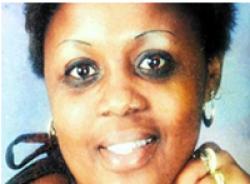June 2012: raped, mutilated, shot, killed and murdered
Phumeza Nkolozi
Thapelo Makhutle
Sasha Lee Gordon
Sana Supa
Hendrieeta Thapelo Morifi
May 2012 Geneva
Navi Pillay spoke loudly against Hate Crimes in South Africa and Africa.
February 2012 Present on Hate Crimes in South Africa at CSW55
Minister of Women, children and people with disabilities Ms.Lulu Xingwana
Minister of Correctional Services Ms Nosiviwe Mapisa-Ngakula
Minister of Social Development Ms Bathabile Dlamini
Deputy Minister of Police Ms Maggie Sotyu
2011 stoned, stabbed and murdered Noxolo Magwaza
2010 raped, murdered and raped again: Nontsikelelo Tyatyeka;
2010-raped, strangled and living Milicent Gaika
2009 beaten to a pulp and later died Girly Nkosi
2008 raped, stabbed and murdered
Eudy Simelane…list continues…
Why are our Women leaders silent…when children are being killed like animals in South Africa?
As I write this article, the silence of women, mothers, and women ministers is deafening. I feel crippled and my bones are no longer strong to stand and I ask for mothers of South Africa and women to stand and fight now to end this massacre.
The list above is nothing to celebrate after Youth Day events on June 16th -celebrating the memories and strength of resisting oppression that lead to the Sharpeville massacre. The above list of youth who have lost lives in the same month we celebrate many youngsters, by year and women we are counting on to take this agenda on and stop killing your children and you to be here and fight for lives of women you know and do not event know.
How could we have celebrated Youth Day when there is again a massacre! Where are the women loving women, lesbians and gay men in my country to stand and stop this gendercide? Who is writing about us and telling the world we are being killed? We need to take stock and action as see fit to be the ones to make a change. Our sisters, mothers, aunts, lovers and women are being raped, murdered, raped again and savagely cut under the gaze of the world.
Ms. Lulu Xingwana in February 2012 she presented at CSW55 on taking action on LGBTI issues of hate crime. Three months later we have bodies of LGBTI people-killed brutally- and No word Ms Minister! The time isnow!
What has happened to women leaders in our country who have not shed a tear or been seen or heard to condemn these crimes? As many mothers cry for their murdered and watch brutally severed bodies- that are not even recognizable many appear to console and give sympathies.
So we wait for the next one and then the next and go for after tears drinks and wait for the next.
It that how we are living, by the gun so to speak?
How many lesbians, women who love women and gender-free people are in line? What are we doing? This is a war declared on our bodies and we Must Stand together and there is not time to shine as individuals. We work together or divided we are falling. Fast into the dust.
Just this past Sunday, we marched in Paris with many women who had the opportunity to be in France from South Africa, at that time bodies were found, women shot, raped and I fear that the silence of our women leaders is serving our deaths. We are in danger with no choice to life.
We marched in solidarity with the world and all people who know of humanity-mothers, fathers, and brothers. Muholi also remarked that the march was for all LGBTI individuals who can’t because of homophobia, lesbophobia, queerphobia, transphobia, xenophobia… all the phobia that are there to be. We made a mark and our presence was clearly heartfelt by those who were there and yet the reality back home is just too scary to imagine, she said.
Muholi said, “Rape has made us powerless, though we threw our hands in the air and said ‘Amandla’ it is a pity that power we supposed to claim is imaginary as we continue to lose our LGBT people along the way”. Muholi, who brought her all women football team Thokozani to participate the Foot for Love Games said she was feeling destroyed inside at the silence of women ministers in particular, those stood in at the Commission on the Status of Women to protect our rights to life. We are worthy women too!
“They read newspapers and none of them have said a word. It is disheartening and I feel crashed at the thought of families who are going through this pain”, she said. And yes we all hear it and it is time that we stand and speak to our mothers and save lives that are falling so fast to dust as we weep and mourn for another life lost.
Mothers, mothers who is protecting your children when they are being attacked and raped and no voice speak to say enough! The men, who are allowed to rape, kill and rape at will -as they please at their pleasure. Is this the freedom we talk about?
We cannot be silenced any longer and those in power that we all vested for you to represent us Stand Up! I am standing! Are you?
This is not JUST to brutally take lives as though they are free for taking! We will not be silenced and-if you choose to remain silent and unheard- then you have blood on your hands! Justice must prevail for all and I call you, you and you to end violence.
Glenda Muzenda
This post first appeared here: http://www.blacklooks.org/2012/07/thinking-through-lesbian-rape-the-silence-is-deafening-crippling-and-deadly/. Thanks to Glenda and to Sokari Ekine for this collaboration.







